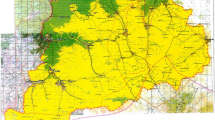Summary
Protection of Forests from Pests in Ukraina
The Author relates, on the basis of many years practical work in forest protection in the Ukrainian Socialist Soviet Republic, on the actual state of forest pests and their control. The 1st part deals with the development and success of chemical control since 1945. Among the products used DDT and HCCH preparations preponderate. Treatment takes place either by local dusting or by aerial spraying on large surfaces.
In the 2nd part the author warns from careless use of chemical control where entomophages or other useful animals may be destroyed along with the pests. It is shown in detail that the degree of infestation depends on the physiological condition of the insect pest on the one hand, on that of the host plant on the other hand. A forecast on egg production of pest insects is possible, at least inPorthetria dispar, according to the size of pupae, which as a whole is proportional to it. In order to determine the degree of parasitation in pest caterpillars a method was worked out at the Kiev Institute, bySirotina, on the basis of the hemolymph picture. The count of healthy eggs and young larvae on model trees allows to determine, according to a formula, the possible damage and according to it the necessary and practicable protective measures.
Physiological resistance of host plants is conditioned by the presence of protective substances in their tissues. These substances are partly of a similar chemical constitution as the commonly used insecticides. They fail to be formed or are unsufficiently so if the trees, mostly in artificial cultures, have been placed under external conditions unfavourable to their species: this is then the cause of mass-infestation by pests. These unfavourable factors may reside in soil conditions, in an improper choice of tree species or of silvicultural measures, and when corrected, the healthy state of stands will be restored.
Résumé
La Protection des Forêts contre les Agents nuisibles en Ukraine
Basé sur ses longues années de pratique dans la Protection des Forêts dans la République Socialiste Soviétique d'Ukraine, l'Auteur donne un aperçu de l'état actuel des insectes nuisibles aux forêts et de la lutte contre eux. Le 1ère partie traite du développement et des succès de la lutte chimique depuis 1945. Parmi les produits que l'on emploie, des préparations à la base de DDT et de HCCH jouent le premier rôle. On les applique ou sous forme de poudre sur les lieux ou d'aspersion spray, depuis des avions, sur des surfaces étendues.
Dans la 2e partie, l'Auteur nous avertit d'un emploi inconsidéré de produits de lutte chimique dans des cas où des entomophages ou d'autres animaux utiles risqueraient d'être également détruits. L'Auteur expose que le degré d'infestation dépend d'une part de l'état physiologique des insectes nuisibles, d'autre part de celui des plantes-hôtes. Le pronostic de la production d'oeufs est possible, au moins chez lePorthetria dispar, d'après la grandeur des chrysalides qui lui est essentiellement proportionnelle. Afin de déterminer l'infestation des chenilles par des parasites, on se sert de l'image de l'hémolymphe d'après une nouvelle méthode mise au point parSirotina à l'Institut de Kiew. Le comptage des oeufs et des larves nouvellement écloses en bonne santé sur des arbres échantillons permet de déterminer, d'après une formule qu'on a établie, le degré possible de dommage et, par consequent, les mesures nécessaires et praticables de protection.
La résistance physiologique des plantes-hôtes est conditionnée par la présence de matières protectives dans leurs tissus, en partie chimiquement parentes aux insecticides en usage. Ces matières ne se forment pas ou en quantité insuffisante si les arbres, le plus souvent en cultures artificielles, ne trouvent pas les conditions externes favorables à leur espèce, ce qui a pour conséquence des attaques en masse par des insectes nuisibles. Ces facteurs défavorables peuvent résider dans les conditions du sol, dans un choix impropre des essences ou des traitements sylvicoles, et leur rectification amènera la guérison.
Similar content being viewed by others
Literaturverzeichnis
Büttner, H., 1956: Die Beeinträchtigung von Raupen einiger Forstschädlinge durch mineralische Düngung der Futterpflanzen. Naturwissenschaften,43, N 19.
Eckstein, K., 1926: Über die Methoden neuzeitlicher Maßregeln gegen Insektenschäden im Walde. Anz. f. Schädlingskde., H. 13.
Rudnew, D. F., 1935: Der große Eichenbock,Cerambyx cerdo L. seine Lebensweise, wirtschaftliche Bedeutung und Bekämpfung. Zeitschrift für angewandte Entomologie, XXII, H. I.
Rights and permissions
About this article
Cite this article
Rudnew, D.F. Schutz der Wälder vor Schädlingen in der Ukraine. Anzeiger für Schädlingskunde 38, 130–137 (1965). https://doi.org/10.1007/BF02290072
Published:
Issue Date:
DOI: https://doi.org/10.1007/BF02290072




